Small Planet Communications, Inc. + 15 Union Street, Lawrence, MA 01840 + (978) 794-2201 + Contact







Long before Europeans explored and colonized the Americas, people from Asia had migrated, explored, and settled the two continents. These first settlers—the Indigenous Peoples of the Americas—developed into diverse cultural groups and created rich, expansive civilizations. Although the earliest European explorers of the Americas were generally seeking new trade routes to better access Asia’s riches, in time they realized that the two continents presented opportunities for exploitation and colonization—and for converting the Indigenous Peoples to Christianity.
Balboa, Vasco Núñez de (1475–1519), Spain Balboa was the first European to sight the eastern shore of the Pacific Ocean. He opened the way for Spanish exploration and settlements of the western coast of South America. Balboa set sail for the New World in 1501 as part of an expedition to the north coast of Colombia. He settled on the island of Hispaniola (now Cuba) and made an unsuccessful attempt at farming. In 1510, to escape his creditors, he stowed away on a Spanish ship heading for the mainland, where the explorers founded the colony of Darién on the Isthmus of Panama. Balboa acted as governor of Darién until King Ferdinand of Spain named an elderly nobleman as official governor. In 1513, Balboa led an expedition to the west, and in September, he sighted the Pacific Ocean, which he claimed for Spain.
Bienville, Jean Baptiste le Moyne, Sieur de (1680–1768), New France (Canada) Bienville was a key figure in the establishment of French dominion on the Gulf of Mexico. Assuming command of the Louisiana colony in 1701, Bienville constructed a fort on Mobile Bay in 1702. In 1710 he founded Mobile, Alabama, on the lower part of the bay. Bienville assumed governorship of Mobile in 1717. He founded the city of New Orleans in 1718.
Block, Adriaen (1567–1627), Netherlands Block was selected by a group of Amsterdam merchants in 1613 to travel to the region of North America explored by Henry Hudson. Block sailed up the Hudson River to winter at Albany then explore Long Island Sound. He sailed to and named Block Island, then went on to explore the Connecticut River and Narragansett Bay. Block's Figurative Map of 1614 was the first map to show details of the southern New England coast and to show that Long Island and Manhattan were separate islands.
Brûlé, Étienne (c. 1592–1632), France Brûlé was likely the first European to see the Great Lakes. In 1608 he journeyed to the New World with fellow explorer Samuel de Champlain. Two years later Champlain sent him to live in the wilderness and learn about Native American life, where Brûlé lived with the Huron Indians. It is during this time that he is believed to have explored what is now the Great Lakes region. Brûlé eventually betrayed Champlain in 1629 by guiding an English fleet up the St. Lawrence River to capture Quebec—and Champlain—who lived in Quebec at the time.
Read Cabeza de Vaca's
account of his historic
journey across North
America, published in
1542.
Cabeza de Vaca, Álvar Núñez (c. 1490–c. 1556), Spain Cabeza de Vaca sailed to Florida with a Spanish expedition in 1527. The party struggled through Florida and was later shipwrecked off the coast of present-day Texas. Most of the survivors either died of exposure or were killed by American Indians. However, Cabeza de Vaca and three companions escaped and wandered about the American South for eight years. During that time, Cabeza de Vaca became an accomplished medicine man among the Native American groups. Eventually, the men traveled west and in 1536 arrived on the Pacific coast of Mexico. They were the first Europeans to cross the continent of North America. Cabeza de Vaca was also the first European to see and describe the American buffalo. Returning to Spain the following year, Cabeza de Vaca later published an account of his travels across North America.
Learn more about John Cabot at
this site sponsored by the Memorial
University of Newfoundland.
Cabot, John (c. 1450–1498), Italy Although he was born in Italy, Cabot served under King Henry VII as an explorer for England for the latter part of his career. In 1497 Cabot sailed from England in search of a shorter route to Asia. After a month at sea, Cabot came upon an unknown land mass in present-day Canada, which he named "new found land," a name that is still used today. Along Newfoundland's coast, Cabot's crew caught large numbers of cod simply by lowering baskets into the water. Believing he had reached a lucrative land off the coast of China, Cabot received approval from Henry VII for a second voyage, with the hope of reaching gem- and spice-rich Japan. He set out in 1498 with five ships, 300 men, and enough supplies for a year's worth of travel. Unfortunately, Cabot and his ships were presumed lost at sea and never heard from again.
Cabrillo, Juan Rodríguez (c. 1499–1543), Portugal Born in Portugal, Cabrillo became a Spanish conquistador in his youth and fought alongside Hernán Cortés against the Aztecs in 1519. Cabrillo joined other Spanish expeditions, one of which resulted in him taking over as captain of an exploration to the Pacific coast. Setting sail in 1542, Cabrillo discovered San Diego Bay. The ship continued north to explore Monterey Bay and Point Reyes, allowing Cabrillo to become the first European to explore present-day California's coastline. Although San Francisco Bay remained undiscovered by Cabrillo, the expedition is still considered a success because he provided written reports that helped later explorers colonize the area.
Read a biography
of Jacques Cartier.
Cartier, Jacques (1491–1557), France Cartier made three voyages to North America between 1534 and 1542. On his first expedition, Cartier entered the Baie de Gaspé in present-day Canada where he stayed for several weeks and established good relations with the American Indians (Laurentian Iroquois) who happened to be fishing in the area. Two Iroquois accompanied Cartier when he returned to France and eventually became interpreters for the French. Cartier's most notable achievement was his discovery of the St. Lawrence River in 1535. He was also the first person to map the coastline of the Gulf of St. Lawrence. Cartier's discovery of the St. Lawrence River helped prepare the way for the eventual French colonization of much of North America.
Champlain, Samuel de (c. 1570–1635), France Champlain traveled to North America 12 times between 1603 and 1635, remaining there for several months at a time. Among his many accomplishments on these voyages, Champlain is considered to be the founder of the New France colony. He also gained much knowledge of the geography of North America. In mapping the Atlantic coastline from Cape Breton to Cape Cod, Champlain became New England's first cartographer. Champlain also discovered a large lake located between present-day New York and Vermont; this lake still bears his name. He founded several settlements in and around the St. Lawrence River Valley, including Quebec City in 1608, which eventually became the capital of New France. In 1612 the king of France named him governor of the colony.
Visit 1492: An Ongoing Voyage.
This site, sponsored by the Library
of Congress, describes the people
and culture of the New World
before the arrival of Columbus. It
also explains how Europe claimed
America.
Columbus, Christopher (1451–1506), Italy Columbus made four voyages to the New World between 1492 and 1504. Though he was born in Italy, Columbus sailed for Spain's King Ferdinand and Queen Isabella. In his first expedition in 1492, Columbus helmed the Santa María. The expedition landed on an island in the Caribbean that is part of the Bahamas archipelago. Columbus named it San Salvador. Local inhabitants met them on the island, and Columbus, believing he had reached the Indies, called the people Indians. On his second voyage, Columbus discovered Puerto Rico and set up a colony on Hispaniola (present-day Dominican Republic) and named the island of Dominica. Columbus landed on the American mainland in the course of his third expedition. On his fourth and final voyage, Columbus explored Mexico, Honduras, Panama, and Jamaica. His explorations marked the beginning of a long period of European colonization in the New World.
Learn more about Coronado at
this PBS-sponsored website.
Coronado, Francisco Vázquez de (1510–1554), Spain Governor of a prestigious Mexican province, Coronado was intrigued by legends of seven cities of gold. Inspired by the explorations of Cabeza de Vaca, Coronado set out in 1540 with 1,300 companions and large herds of livestock in search of gold in the north. When Coronado reached the pueblos of the northern Zuni people, he tried to convert them to Christianity and make them swear allegiance to the Spanish king and queen. A fight ensued, and the battle-ready Spaniards forced the Zuni out of their pueblos. After a thorough search of the pueblos, Coronado found no gold. Dividing his men, Coronado sent several parties west to explore the Grand Canyon, the Colorado River, and present-day New Mexico. Coronado himself led another group east into present-day Kansas in search of the fabled city of Quivira. Finding no riches in either place, Coronado returned to Mexico, where the Spanish Viceroy declared his expedition a complete failure. Based on Coronado's chronicle of the expedition, however, it is recognized today as one of the greatest explorations of the American Southwest.
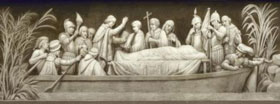
Click the image above for a larger view of the
"Burial of De Soto" which is part of the frieze in
the Rotunda of the U.S. Capitol.
De Soto, Hernando (c. 1500–1542), Spain De Soto gained experience as a conquistador by helping Francisco Pizarro conquer the Inca civilization in 1533. Acquiring great wealth from this conquest, King Charles V of Spain instructed De Soto to use his newfound wealth to "conquer, populate, and pacify" the land of Florida. De Soto set out with nine ships, more than 600 soldiers, horses, livestock, and weapons. The company arrived on the Florida coast near present-day Tampa Bay in 1539. Rather than settling down and colonizing Florida, De Soto set out in search of more wealth and treasure. He and his men advanced northward through Florida, Georgia, the Carolinas, Tennessee, and Alabama in their search for silver and gold. In 1541 De Soto led the first European expedition to the Mississippi River. The group continued up the Arkansas River into Oklahoma, but De Soto and his men found no treasure. Although De Soto failed to attain the wealth he had hoped to find in the American Southeast, the expedition's written records of the land, descriptions of interactions with Native Americans, and first-hand accounts of the survivors remain an enduring part of American history.
Read a biography
of former pirate,
Sir Francis Drake.
Drake, Francis Sir (c. 1540–1596), England An accomplished explorer whose achievements and wealth led to his being knighted by Queen Elizabeth I, Drake was the first Englishman to see the Pacific Ocean, the first Englishman to sail the Straits of Magellan, and the first Englishman to circumnavigate the world. Drake began his career as a pirate, attacking Spanish ships, with whom England had a bitter rivalry during that period in history. On his second expedition in 1577, Drake sailed toward the Pacific coast of the New World. He sailed up the coast of present-day Washington then turned west into the Pacific. He sailed through the Pacific Islands, around the Cape of Good Hope and returned to England with both treasure and fame. The trip earned him the distinction of being the second person in history to circumnavigate the world. (Ferdinand Magellan of Portugal was the first.) In 1585 Drake set out once again to plunder Spanish ships and cities in the West Indies and Florida. On his journey home, he picked up the surviving Roanoke Island colonists and brought them back to England. In 1587 Drake went on to lead an attack on the Spanish fleet at Cadiz, destroying 30 Spanish ships that were preparing for an attack on England. The following year, he was named vice admiral in the English fleet that defeated the Spanish Armada.
Dulhut, Daniel Greysolon, (1636–1710), France Duluth explored and traded in the Great Lakes region in the 1680s. He established French authority in the area while working peacefully with Native American tribal nations and successfully negotiating the release of previous explorers held captive, including explorer Father Hennepin. Duluth's most notable achievement was gaining land surrounding Lake Superior and the upper Mississippi region for France.
DID YOU KNOW?
Ericsson earned the nickname
"Leif the Lucky" on the return
trip from Norway when he saved
15 people in a shipwreck.
Eriksson, Leif (c. A.D. 980–1020), Iceland Around A.D. 1000, Eriksson was most likely the first European ever to set foot on North America. The son of famed Viking explorer Erik the Red, Eriksson spent the majority of his childhood in Greenland. At an early age, he traveled to Norway, where he converted to Christianity in the court of King Olaf I. The king then sent him back to Greenland to spread Christianity among the people there. According to the Hauksbok, a collection of old Norse sagas, there are two different versions of Ericsson's adventure home. One saga describes how Eriksson's ship was blown off course, and instead of returning to Greenland, Eriksson landed on North America. Another saga tells of a different Norse explorer who, fifteen years earlier, sighted the coast of North America but did not land there. Ericsson set out years later with a crew to find the unknown land. Both versions describe how Ericsson landed on North America, and finding rich soil, wheat, and wild grapes, named it Vinland, (Wineland). Historians agree that Ericsson's party probably landed on the northern tip of Newfoundland.
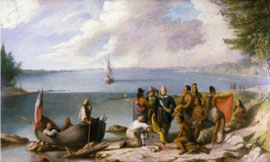
Bartholomew Gosnold landing on the New
Bedford coast in 1602.
Gosnold, Bartholomew (c. 1572–1607), England In 1602 Gosnold led an exploration of New England's coastline from Maine to Narragansett Bay. He named Cape Cod and Martha's Vineyard (after his infant daughter) during the journey and built a fort on Cuttyhunk Island. Five years later, Gosnold captained the God Speed, one of three ships that carried Virginia's first settlers. He opposed making Jamestown the site of the first English settlement, but was overruled. Gosnold died of malaria in Jamestown several months later.
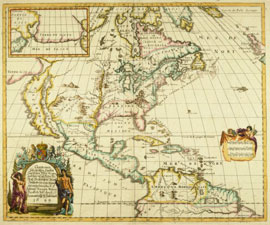
Read more about Hennepin.
Hennepin, Louis (1626–c. 1701), Belgium Father Hennepin was a Flemish Franciscan missionary who sailed to New France in 1675. In 1678, he traveled with French explorer La Salle throughout the Great Lakes region. While exploring present-day Illinois, La Salle returned north to obtain fresh supplies, but he sent Hennepin's group on to explore the upper Mississippi River valley. They followed the river northward into present-day Minnesota when Sioux Indians captured Hennepin's party. During their travel with the Sioux, Hennepin saw and named St. Anthony Falls. French explorer Duluth eventually negotiated their release with the Native Americans, and Father Hennepin returned to France. Hennepin drew detailed maps of the upper Mississippi region. He also wrote and published many accounts of his travels, though they were not always accurate. Still, his accounts are important because they included the first descriptions of the upper Mississippi and Niagara Falls.
View a detailed account of the
life of Henry Hudson.
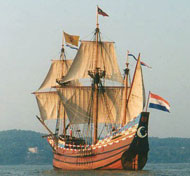
The image above is a replica of
Hudson's ship the Half Moon, in
which he discovered the Hudson
River and present-day New York
in 1609.
Hudson, Henry (c. 1565–1611), England Hudson led four arctic voyages in search of a Northwest Passage to Asia. Though he never achieved this goal, each voyage resulted in notable explorations and discoveries. In 1607 Hudson sailed closer to the North Pole than any previous explorer before turning back to England. On his second attempt in the following year, Hudson sailed around the northern tip of Norway. Hired by the Dutch East India Company in 1609, Hudson helmed the ship Half Moon, or De Halve Maen. Blocked by ice yet again, Hudson gave in to his grumbling crew and turned the ship southward. The Half Moon entered a large river (now known as the Hudson River) and followed it as far as Albany, giving Holland their claim to the area. Hudson set out on his fourth and final voyage in 1610 from England. He guided the ship Discovery through icy waters in the present-day Hudson Strait before sailing into a large body of water that Hudson believed to be the Pacific Ocean. That body of water is now known as Hudson Bay. Since no outlet was found on the other side, the party wintered there amid increasingly icy waters. In the spring of the following year, the Discovery crew mutinied. Hudson and seven other men were set adrift in a small boat and never seen again.
Jolliet, Louis (1645–1700), New France (Canada) A French-Canadian fur trader and expert cartographer, Jolliet was commissioned by the governor of New France to explore the path of the Mississippi River. Jolliet and French missionary Father Jacques Marquette together explored the Great Lakes region and charted the Mississippi as far south as the Arkansas River. During their expedition, they befriended Native Americans and learned that the Mississippi emptied into the Gulf of Mexico rather than the Pacific Ocean like they had hoped. Because they feared Spanish colonists farther south, they turned back. A friendly Native American shortened their return trip by describing a route up the Illinois River to Lake Michigan. Jolliet wrote a comprehensive journal about their expedition and created many maps, however, most of his documents were lost in a canoe accident. Jolliet went on to explore parts of New France and was named royal cartographer in 1697.
DID YOU KNOW?
A 1963 Norwegian expedition
discovered the remains of a
Viking settlement in northern
Newfoundland. Carbon dating
confirms the site was used
around A.D. 1000.
Karlsefni, Thorfinn (c. 980–?), Iceland Karlsefni established the first European colony in North America around A.D. 1010. Set up in Vinland, the same area where Viking explorer Leif Ericsson had wintered ten years earlier, the settlement consisted of 160 men, five women, and some livestock. During their stay, Karlsefni's wife gave birth to a son, making him the first child of European descent born in North America. Because of attacks from the Native inhabitants, the colony was abandoned after three years.
Kelsey, Henry (1667–1724), England Henry Kelsey was the first European to explore the Canadian prairies. He became an apprentice with Hudson's Bay Company at the age of ten to learn the fur trade business. In 1689 Kelsey went north to the Churchill River to help build Fort York. Because of his youth and adventurous spirit, Kelsey was selected in 1690 to explore the Canadian interior from Hudson Bay to the prairies. He got along well with the Native inhabitants and traveled with a group of Cree out of York. Traveling by ship, canoe, and on foot, Kelsey kept a journal of all the plants and animals he saw. He spent two years living with a Plains Nations group, who told him about a "great wall of mountains" farther west. The Native people were describing the Rocky Mountains. Kelsey worked with Hudson's Bay Company for 30 years as an explorer, trader, and later governor of their trading posts. Kelsey did not receive proper recognition for his explorations until his journals were rediscovered in 1929.
Kino, Eusebio Francisco (c. 1644–1711), Spain Father Kino was a missionary and explorer who established over 20 Spanish missions in the American Southwest. In 1681 he traveled to New Spain as the royal astronomer for an expedition set to colonize present-day southern California. He established Tumacácori in 1691, which is now a U.S. National Historical Park located in Arizona. Father Kino made lasting contributions in agriculture and in the domestication of livestock, creating a cultural blend of Old World and New World elements. Skilled in cartography, Kino drew the first accurate maps of Pimer a Alto, Baja California, and the Sea of Cortez. His explorations proved that Baja California was a peninsula, not an island. Father Kino's 1705 map of Pimer a Alto was the standard reference for the area for more than a century.
La Salle, Rene Robert Cavelier, Sieur de (1643–1687), France A French explorer and fur trader in Canada in 1666, La Salle became interested in reports of an extensive river system that flowed from the Great Lakes region into the Pacific Ocean. He sold his land holdings in Canada and set out in search of this possible water route to China. On a 1669 expedition, La Salle discovered the Ohio River, but he turned back before reaching the Mississippi. Four years later, the French exploration team of Marquette and Jolliet discovered and charted the Mississippi as far south as the Arkansas River. In 1682 La Salle led the first European expedition all the way down the Mississippi River to its delta at the Gulf of Mexico. He claimed the entire territory drained by the Mississippi and its tributaries for France. La Salle named it Louisiana for King Louis XIV. The Louisiana Territory included all the land between the Appalachian and Rocky Mountains and stretched from the Great Lakes to the Gulf of Mexico.
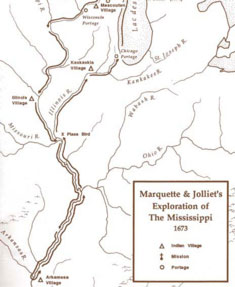
View a larger map and read more about
Marquette's and Jolliet's exploration of
the Mississippi.
Marquette, Jacques (1637–1675), France A Jesuit missionary, Father Marquette moved to New France (Canada) in 1666. There he learned five Native American languages and came to know the Native inhabitants around the Great Lakes. In 1673 he and French-Canadian cartographer Louis Jolliet together explored the Great Lakes region and charted the Mississippi as far south as the Arkansas River. During their expedition, they befriended Native Americans along the way and learned that the Mississippi emptied into the Gulf of Mexico rather than the Pacific Ocean like they had hoped. Because they feared Spanish colonists farther south, they turned back. A friendly Native American shortened their return trip by describing a route up the Illinois River to Lake Michigan. Marquette grew ill during the return trip and died at a mission in present-day Green Bay in 1675.
Nicolet, Jean (1598–1642), France Nicolet was the first European to see Lake Michigan and present-day Wisconsin. In 1618 he traveled to New France (Canada) with explorer Samuel de Champlain as an interpreter. He lived for several years with an Algonquian group near Lake Huron and interacted with the Iroquois and Nipissing as well. Nicolet led a 1634 expedition through the Straits of Mackinac where he discovered Lake Michigan. The group continued on to the western shoreline of Green Bay where Nicolet befriended more Native Americans and explored what is now Wisconsin. Unsuccessful in finding the Northwest Passage to the Pacific, Nicolet returned to Quebec in the fall of 1634.
Oñate, Juan de (c. 1550–1626), New Spain (Mexico) Oñate founded the colony of New Mexico in 1595 after being granted a contract by King Philip II of Spain. Three years later he settled the San Juan pueblo in the northern Rio Grande valley as the government center of New Mexico. With the new colony suffering from cold weather and short food supplies, Oñate launched explorations as far north as Kansas and as far west as the Gulf of California in search of wealth. Unable to find the vast riches the area was thought to hold, Oñate resigned in 1607.
Pineda, Alonso Álvarez de (?–1520), Spain In 1519 Pineda led a Spanish expedition in search of a water route from the Gulf of Mexico to the Pacific Ocean. Sailing from Jamaica, Pineda and his group of men mapped the entire coastline of the Gulf from Florida to present-day Vera Cruz, Mexico. Upon his arrival in Vera Cruz, Pineda encountered Hernán Cortés, who had already claimed the area for Spain and was threatened by Pineda's expedition. Although the expedition did not find a passage to the Pacific, Pineda and his crew proved that Florida was not an island, as had been initially reported by Ponce de León in 1513.
Read about Ponce de León.
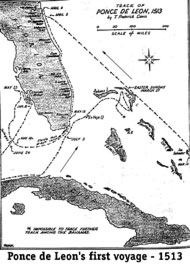
Trace the path of Ponce de León
by clicking on the map. It is a popular
myth that Ponce de León also searched
for the "fountain of youth." Read why
this myth lives on.
Ponce de León, Juan (c. 1460–1521), Spain Ponce de León sailed with Christopher Columbus on his second journey to the New World in 1493. Settling on the island of Hispaniola (present-day Dominican Republic), Ponce de León was soon named deputy governor. He discovered a nearby island and became wealthy when he found large amounts of gold there. Naming it Puerto Rico, Ponce de León colonized the island and was appointed governor in 1508 by King Ferdinand of Spain. In search of more treasure and new lands, Ponce de León sailed through the Bahamas before discovering and claiming Florida for Spain in 1513. He called the land that he believed to be an island La Florida, meaning "place of flowers." He went on to explore the Florida Keys and part of the west coast of the peninsula before returning to Puerto Rico. In 1521 Ponce de León set out with 200 people, horses, and agricultural equipment to colonize Florida. Ambushed by Native Americans upon landing, Ponce de León was fatally wounded, and the colonization attempt was abandoned.
Portolá, Gaspar de (1717–c. 1784), Spain Portolá was the first governor of the Californias and the discoverer of San Francisco Bay. In 1769 he led a large land and sea expedition of soldiers, settlers, and missionaries to create Spanish bases along the California coast. Portolá founded the first European settlement at San Diego in 1769 and in Monterey the following year.
Read a biography of
Giovanni da Verrazzano.
Explore a first-hand account
of his adventures.
Verrazzano, Giovanni da (1485–1528), Italy An Italian explorer who sailed for France, Verrazzano crossed the Atlantic in 1523 in search of a western passage to Asia. While exploring the New World, Verrazzano discovered present-day New York harbor, Block Island, and Narragansett Bay, all of which he claimed for France. Although his expedition did not lead to Asia, Verrazzano gained fame for himself and France for his discoveries. Verrazzano crossed the Atlantic again in 1528, along with his brother. They explored the Florida coast, the Bahamas, and the Lesser Antilles. When Verrazzano anchored off the island of Guadalupe, he was likely killed by Native Islanders called Caribs.
Read a first-hand account
of Vespucci's 1497 voyage.
Vespucci, Amerigo (1454–1512), Italy Vespucci was the first explorer to reach present-day South America and recognize it as a continent separate from Asia. Sailing along its northern coast, Vespucci explored the mouth of the Amazon River and discovered the Río de la Plata. On his 1501 voyage, Vespucci accomplished something even more significant. Inventing a system to compute longitude, he accurately calculated the circumference of the earth to within 50 miles of the correct measurement. Vespucci returned to Spain and was granted the prestigious title of pilot major. Amateur cartographer Martin Waldseemüller published an account of Vespucci's voyages, along with a map in 1507. In honor of Vespucci's discovery, Waldseemüller labeled the new continent America.
Vincennes, Francois-Marie Bissot, Sieur de (1700–1736), New France (Canada) Vincennes was the son of explorer Jean-Baptiste Bissot who built a fort at present-day Fort Wayne, Indiana, and befriended the nearby Miami, one of the Native Great Lake nations. Taking over for his father in 1719, Vincennes later established a trading post on the lower Wabash River, which the townspeople named for him after his death.
For additional perspectives on the European exploration, conquest, and colonization of North America, visit Contact—American Beginnings: 1492–1690 by the National Humanities Center. For a lesson on early contact between Native North Americans and the Europeans, visit Native North Americans by the National Archives of Great Britain.
America's Explorers | Bibliography
- Biography Base. "Adrian Block Biography." Accessed 6/7/19. http://www.biographybase.com/biography/Block_Adrian.html
- British Broadcasting Corporation (BBC). "Christopher Columbus (1451–1506)." Accessed 6/7/19. https://www.bbc.co.uk/history/historic_figures/columbus_christopher.shtml
- British Broadcasting Corporation (BBC). "The First People Who Populated the Americas" by Melissa Hogenboom. Accessed 6/7/19. http://www.bbc.com/earth/story/20170328-the-first-people-who-populated-the-americas
- British Broadcasting Corporation (BBC). "Sir Francis Drake." Accessed 6/7/19. https://www.bbc.co.uk/history/historic_figures/drake_francis.shtml
- British Broadcasting Corporation (BBC). "Suffolk Explorer Bartholomew Gosnold." Accessed 6/7/19. http://www.bbc.co.uk/suffolk/dont_miss/usa/gosnold/
gosnold.shtml - Canadian Museum of Civilization. "The Explorers: Daniel Greysolon Dulhut." Accessed 6/7/19. https://www.historymuseum.ca/virtual-museum-of-new-france/the-explorers/daniel-greysolon-dulhut-1678-1679/
- Canadian Museum of Civilization. "The Explorers: Jacques Cartier." Accessed 6/7/19. https://www.historymuseum.ca/virtual-museum-of-new-france/the-explorers/jacques-cartier-1534-1542
- City of Vincennes, Indiana. "History of Vincennes." Accessed 6/7/19. http://www.vincennes.org/dev/history/
- Clayton, Lawrence A. "Hernando de Soto Biography." Accessed 6/7/19. http://www.floridahistory.com/larrys.html
- Dictionary of Canadian Biography. "Henry Kelsey." Accessed 6/7/19. http://www.biographi.ca/en/bio/kelsey_henry_2E.html
- Dictionary of Canadian Biography. "Jacques Cartier." Accessed 6/7/19. http://www.biographi.ca/en/bio.php?BioId=34229
- Dictionary of Canadian Biography. "Jean-Baptiste Le Moyne de Bienville." Accessed 6/7/19. http://www.biographi.ca/en/bio.php?id_nbr=1486
- EnchantedLearning.com. "Christopher Columbus: Explorer." Accessed 6/7/19. http://www.enchantedlearning.com/explorers/page/c/columbus.shtml
- Enchanted Learning. "Explorers of North and Central America." Accessed 6/7/19. https://www.enchantedlearning.com/explorers/namerica.shtml
- Encyclopædia Britannica. "Bartholomew Gosnold." Accessed 6/7/19. http://www.britannica.com/EBchecked/topic/239482/Bartholomew-Gosnold
- Encyclopædia Britannica. "Étienne Brûlé." Accessed 6/7/19. http://www.britannica.com/EBchecked/topic/82078/Etienne-Brule
- Encyclopædia Britannica. "Eusebio Kino." Accessed 6/7/19. https://www.britannica.com/biography/Eusebio-Kino
- Encyclopædia Britannica. "Gaspar de Portolá." Accessed 6/7/19. http://www.britannica.com/EBchecked/topic/471287/Gaspar-de-Portola
- Encyclopædia Britannica. "Giovanni da Verrazzano." Accessed 6/7/19. http://www.britannica.com/EBchecked/topic/626406/Giovanni-da-Verrazzano
- Encyclopædia Britannica. "Henry Hudson." Accessed 6/7/19. http://www.britannica.com/EBchecked/topic/274681/Henry-Hudson
- Encyclopædia Britannica. "Jean Nicolet." Accessed 6/7/19. http://www.britannica.com/EBchecked/topic/414401/Jean-Nicolet
- Encyclopædia Britannica. "Leif Eriksson: Student Encyclopedia." Accessed 6/7/19. http://kids.britannica.com/comptons/article-9274197/Leif-Eriksson
- Encyclopædia Britannica. "Louis Hennepin: Student Encyclopedia." Accessed 6/7/19. http://kids.britannica.com/comptons/article-9274841/Louis-Hennepin
- Encyclopædia Britannica. "Louis Jolliet: Student Encyclopedia." Accessed 6/7/19. http://kids.britannica.com/comptons/article-9275175/Louis-Jolliet
- Encyclopædia Britannica. "Thorfinn Karlsefni." Accessed 6/7/19. http://www.britannica.com/EBchecked/topic/593237/Thorfinn-Karlsefni
- Florida Center for Instructional Technology. "Ponce de León: Florida's First Spanish Explorer." Accessed 6/7/19. http://fcit.usf.edu/Florida/lessons/de_leon/
de_leon1.htm - History Channel. "Exploration of North America." Accessed 6/7/19. https://www.history.com/topics/exploration/exploration-of-north-america
- History Channel. "Leif Eriksson." Accessed 6/7/19. http://www.history.com/topics/leif-eriksson
- The Independent. "Evidence of First Ever Humans to Colonise North America Found by Scientists" by Josh Gabbatiss. Accessed 6/7/19. https://www.independent.co.uk/news/science/north-america-first-humans-colonist-evidence-scientists-alaska-genetics-a8140231.html
- Infoplease. "Amerigo Vespucci." Accessed 6/7/19. http://www.infoplease.com/encyclopedia/people/vespucci-amerigo.html
- Infoplease. "Christopher Columbus: Voyages to the New World." Accessed 6/7/19. http://www.infoplease.com/encyclopedia/people/columbus-christopher-voyages-to-new-world.html
- Infoplease. "Eusebio Francisco Kino." Accessed 6/7/19. http://www.infoplease.com/encyclopedia/people/kino-eusebio-francisco.html
- Infoplease. "Hernando De Soto." Accessed 6/7/19. http://www.infoplease.com/encyclopedia/people/de-soto-hernando.html
- Infoplease. "Jean Baptiste Bissot Vincennes, sieur de." Accessed 6/7/19. http://www.infoplease.com/encyclopedia/people/vincennes-jean-baptiste-bissot-sieur-de.html
- Infoplease. "Juan Ponce de León." Accessed 6/7/19. http://www.infoplease.com/encyclopedia/people/ponce-de-leon-juan.html
- Infoplease. "Thorfinn Karlsefni." Accessed 6/7/19. http://www.infoplease.com/encyclopedia/people/thorfinn-karlsefni.html
- Library and Archives Canada. "Henry Kelsey: On the Trail of Native Friends." Accessed 6/7/19. http://epe.lac-bac.gc.ca/100/206/301/lac-bac/explorers/www.collectionscanada.gc.ca/explorers/kids/h3-1510-e.html
- Library and Archives Canada. "Henry Kelsey: The Young Adventurer." Accessed 6/7/19. http://epe.lac-bac.gc.ca/100/206/301/lac-bac/explorers/www.collectionscanada.gc.ca/explorers/h24-1510-e.html
- Library and Archives Canada. "Louis Jolliet and Jacques Marquette: Discovering the Mississippi." Accessed 6/7/19. http://epe.lac-bac.gc.ca/100/206/301/lac-bac/explorers/www.collectionscanada.gc.ca/explorers/h24-1470-e.html
- Library and Archives Canada. "Samuel de Champlain: Explorer." Accessed 6/7/19. http://epe.lac-bac.gc.ca/100/206/301/lac-bac/explorers/www.collectionscanada.gc.ca/explorers/h24-1410-e.html
- Library and Archives Canada. "Thorfinnr Thodarson." Accessed 6/7/19. http://epe.lac-bac.gc.ca/100/206/301/lac-bac/explorers/www.collectionscanada.gc.ca/explorers/kids/h3-1215-e.html
- Lienhard, John H. "Amerigo Vespucci." University of Houston. Accessed 6/7/19. http://www.uh.edu/engines/epi43.htm
- Live Science. "The First Americans: Ancient DNA Rewrites Settlement Story" by Mindy Weisberger. Accessed 6/7/19. https://organpipehistory.com/orpi-a-z/father-kino
- National Geographic Society. "When, How Did the First Americans Arrive? It’s Complicated" by Simon Worrall. Accessed 6/7/19. https://news.nationalgeographic.com/2018/06/when-and-how-did-the-first-americans-arrive--its-complicated-
- National Maritime Museum. "John and Sebastian Cabot." Accessed 6/7/19. http://www.rmg.co.uk/explore/sea-and-ships/facts/explorers-and-leaders/john-and-sebastian-cabot
- National Park Service. "Cabrillo: A Voyage of Discovery at Cabrillo National Monument." Accessed 6/7/19. http://www.nps.gov/cabr/index.htm
- National Park Service. "De Soto: An Epic Journey into the New World." Accessed 6/7/19. http://www.nps.gov/deso/index.htm
- National Park Service. "Padre Island: The Spanish." Accessed 6/7/19. http://www.nps.gov/pais/historyculture/spanish.htm
- National Park Service. "Tumacácori: Always Changing - Forever the Same." Accessed 6/7/19. http://www.nps.gov/tuma/index.htm
- National Park Service. "Tumacácori: San José de Tumacácori." Accessed 6/7/19. http://www.nps.gov/tuma/historyculture/tumacacori.htm
- National Public Radio (NPR). "Coming to America: Who Was First?" by Eric Weiner. Accessed 6/7/19. https://www.npr.org/templates/story/story.php?storyId=15040888
- North Carolina Museum of History. "American Indians at European Contact" by John W. Kincheloe, III. Tar Heel Junior Historian 47:1 (Fall 2007). Accessed 6/7/19. https://www.ncpedia.org/history/early/contact
- Public Broadcasting Service (PBS). "Francisco Vázquez de Coronado." Accessed 6/7/19. http://www.pbs.org/weta/thewest/people/a_c/coronado.htm
- Robinson Library. "René-Robert Cavalier, Sieur de La Salle." Accessed 6/7/19. http://www.robinsonlibrary.com/america/canada/history/lasalle.htm
- San Diego History Center. The History of San Diego: v.1 The Explorers, 1492-1774. Copley Press. Accessed 6/7/19. https://sandiegohistory.org/archives/books/explorers
- The Society of Colonial Wars in the State of Connecticut. "1614 Adriaen Block." Accessed 6/7/19. https://www.colonialwarsct.org/1614.htm
- Smithsonian Institution. "When Did Humans Come to the Americas?" by Guy Gugliotta. Accessed 6/7/19. https://www.smithsonianmag.com/science-nature/when-did-humans-come-to-the-americas-4209273/?all
- Texas State Historical Association. "Alonso Álvarez de Pineda." Accessed 6/7/19. https://www.tshaonline.org/handbook/online/articles/fal72
- Texas State Historical Association. "Álvar Núñez Cabeza de Vaca." Accessed 6/7/19. https://www.tshaonline.org/handbook/online/articles/fca06
- Texas State Historical Association. "Juan de Oñate." Accessed 6/7/19. http://www.tshaonline.org/handbook/online/articles/fon02
- Texas State Historical Association. "René Robert Cavelier, Sieur de La Salle." Accessed 6/7/19. http://www.tshaonline.org/handbook/online/articles/fla04
- Texas State Library & Archives Commission. "Robert Cavelier, Sieur de La Salle." Accessed 6/7/19. https://www.tsl.texas.gov/treasures/giants/lasalle/lasalle-01.html
- Wisconsin Historical Society: American Journeys. "A New Discovery of a Vast Country in America (v. 1)” by Louis Hennepin. Accessed 6/7/19. http://www.americanjourneys.org/aj-124a/summary/index.asp
- Wisconsin Historical Society. "Landfall of Jean Nicolet in Wisconsin (1634)." Accessed 6/7/19. http://www.wisconsinhistory.org/museum/exhibits/
framed/landfall.asp
America's Explorers | Image Credits
- Burial of De Soto | Artist: Constantino Brumidi, 1876; Architect of the Capitol
- Gosnold at the Smoking Rocks | Artist: William Allen Wall, 1842; New Bedford Whaling Museum
- Hennepin Map | Creator: Louis Hennepin, 1699; University of Minnesota, Libraries, James Ford Bell Library
- Hudson's Ship Half Moon | Replica Ship Half Moon and the New Netherland Museum
- Marquette and Jolliet's Explorations of The Mississippi, 1673 | Illinois State Museum
- Track of Ponce de León, 1513 | Creator: T. Frederick Davis; Historical Preservation Society of the Upper Keys
© 2020 Small Planet Communications, Inc. + Terms/Conditions + 15 Union Street, Lawrence, MA 01840 + (978) 794-2201 + planet@smplanet.com


